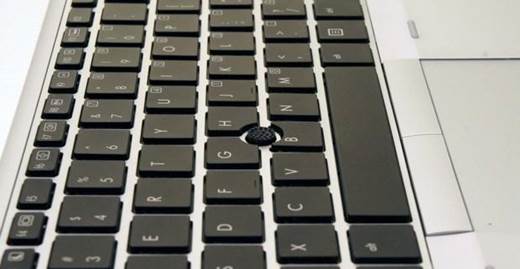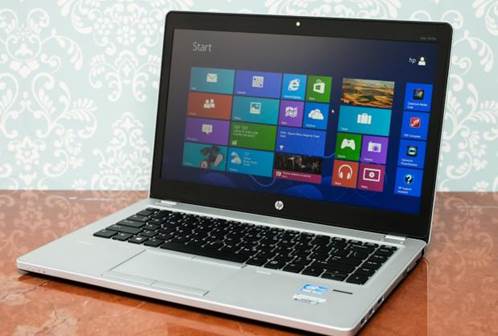In this way or that way, there seems to be
no excuse for a bad keyboard on a computer aimed for business users – actually,
there is no excuse for anything that makes it more difficult for you to
complete your work. Fortunately, the Folio offers a comfortable keyboard –
probably it is more comfortable than you would expect provided that this is a
thin computer. While many Ultrabooks have flat and lifeless keys, the Folio
provides incredible elasticity, so you can type fast and do not have to worry
whether your keystrokes can be realized or not.

The
trackpad is as good as the keyboard.
The buttons also have good space between
each other, and it seems HP does not need to shrink any important keys such as
Enter or Backspace. The compromise seems to focus mainly on the arrow keys:
while the left and right arrow keys have quite a lot of space, the small up and
down are stacked on top of each other, making it easy to hit the wrong key. It
will not be a problem for some people, but if you're like us, having the tendency
to highlight text using the keyboard, you will need to keep track of where to
put your fingers down. As you expected on a high-end system, the Folio has a
backlit keyboard, which can be turned on and off by using the F11 key.
Fortunately, the trackpad is as good as the
keyboard – something we wish we could say about every laptop we've tested. As it
happens, it is a touchpad with good old-fashioned left and right buttons, as
opposed to the new touchpad where the entire surface is a giant and clickable button.
Somehow, we did not see this as a coincidence: the traditional touch buttons
may seem outdated, but when we see them, they almost always seem to work
perfectly. Or, at least working more smoothly than the clickpads, which have a
nasty habit of mistaking left clicks for right clicks. Here, the finish feels
as smooth as glass, and it provides good response to several multi-gestures,
not to mention single-finger navigation. At the same time the buttons are also easy
to press.

The
trackpad is as good as the keyboard.
However, in case the touchpad does not work
for you, there is also a pointing stick inserted between the G and H keys,
along with two extra touch buttons located just below the space bar. Compared to
the version on new ThinkPad devices, this is taller and slightly shallower
(again, Lenovo sets pretty high standards). However, the spoon shape and bumpy
texture make it less possible for your fingers to slip out. The tracking also feels
accurate, which is obviously a plus.
Screen and sound
The Folio has a bright anti-glare screen,
which will satisfy most business users, though it also serves as a reminder
that the anti-glare surface is not necessarily meant providing a good viewing
angle. If you put the laptop in your lap and push its screen forward, you will
immediately notice the diluted color. However, viewing the screen from a side is
a little easier, and if it is not convenient when you stay at home watching
movies in your free time, at least it can make the presentation easier.

If
you put the laptop in your lap and push its screen forward, you will
immediately notice the diluted color
In addition to the viewing angle, the
biggest disadvantage here is the screen resolution. We admit that 1,366x768
will be good enough for many consumers, especially when the price is low. But
in this case, we are looking at an expensive computer, and also it is not
ordinary users, but actually savvy users who prefer the 1,600x900 resolution,
if not 1080p. Fortunately, a 1,600x900 option is coming to U.S. and European
consumers, but it will not be available until early March.
As you would expect, sound quality is not
the strength of business computers. Sound is low, as the case on many laptops,
but we also found that the sound never got very loud, even when the volume was set
to the maximum.
Performance and battery life
Our $1,349 specification has the Intel Core i5 processor-3237U, 4GB of
RAM, and a 180GB SSD, also manufactured by Intel. If these raw data are any
indication, it is just as fast as, if not faster than, most Windows 8 systems
we have tested. It’s PCMark 7 score of 4762 was slightly higher than what we have
seen from other computers, while solid-state drives is among the fastest
(despite Acer Aspire S7’s RAID 0 setting). In particular, it achieved the
highest read speed of 553MB/s and the write speed of up to 519MB/s, according
to ATTO test. We have seen a few other Windows 8 systems with the same read
speeds (like Dell XPS 12, Toshiba Satellite U925t and Acer Iconia W700, for
example), but most of them cannot compete when it comes to write performance.

Speaking in more practical aspects, the
computer boots up in 11 seconds, only a bit faster than what we saw in systems
with the same configuration. (Note: we're talking about 11 seconds versus 12
seconds, so the difference is really negligible in practice). Overall, the
machine was able to catch up when we jumped from one application to another,
and it was also faster when we launched new programs.
As for graphics performance, the Folio
seems to be just average: its scores are somehow similar to other Ultrabooks
using Intel’s HD 4000 integrated graphics solution. That is, you can play old
games that do not require heavy graphics as long as you do not set it at the
maximum settings. However, you will need good luck to achieve 30fps.
As soon as we were beginning to wonder
whether all Windows 8 PCs were cursed by short battery life, we began to examine
some winners. The first was the Acer Iconia W700, a tablet / laptop hybrid that
lasts more than 7 hours. Now we have the EliteBook Folio, which reached 6 hours
18 minutes in battery tests (video looping, Wi-Fi on, brightness fixed at 65
percent). If you look at the above table, you will see that it is the best result
we've ever seen from an Ivy Bridge Ultrabook of any size.
We must admit we expected the Folio would
do better than a touchscreen computer, as touchscreens are well-known for consuming
battery very fast. However, it is significantly better than other non-touch Ultrabooks,
including the Asus Zenbook Prime UX51vz and the ThinkPad X1 Carbon.